Modeling the interactions
|
Vortex model did away with the myth of the repulsion of protons in the nucleus under the influence of their own charge. Inside the nucleus, there is a periodic system as outside of it. Nucleons in the nucleus are grouped into four sectors ball. |
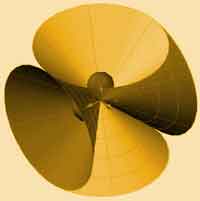 |
| Protons are located in the core sectors of the two ball-axis OZ, neutrons are collected in two sectors of the ball along the axis OX. Structure of the proton and neutron parts of the kernel have cylindrical symmetry, which provides the observed values ??of the spins. |
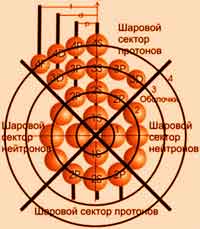 |
| In the first shell fits only one proton 1S. In the second shell has room for four protons. One of them (2S) is located on the axis, and three protons (2l +1 = 2 * 1 +1 = 3) took place on the same shell around it. Dimensions of nucleons such that free space, for example, for the fourth 2P-proton is not. |
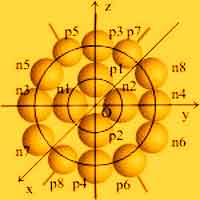 |
| Model of the nucleus of an atom of oxygen. Core is a system of nucleons in four sectors of the ball. At the base of the core is an alpha particle. |
Particles have a finite size - it's the reason rounding particles obstacles |
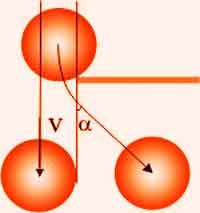 |
| The diffraction pattern arising from the interaction of a photon with the vortex edge barrier. |
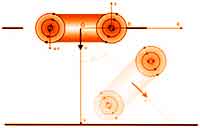 |
| The incident photon is directed along the axis of the momentum p. The collision with the edge of obstacles by the force of the elastic vortex rotates around a point on the barrier. The position of the vortex after passing holes shown. The moment became a transverse component. |
|
Earth is immersed in the graviton environment in which gravitons are moving in all directions at the speed of light, creating a background pressure. |
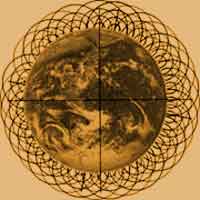 |
| In the surface layer of the Earth's path flows of gravitons strongly curved. The intensity of the flow decreases with distance, so that a vertical gradient of intensity. |
Strong, electromagnetic, and gravitational interactions due to the vortex structure of matter
Strong interaction
Vortex model did away with the myth of the exchange mechanism of the strong interaction. Strong interaction - is a hydrodynamic process of attraction of vortices
The reason for the interaction between particles is at a deeper level of matter, than the level of particles. "Carriers" of all kinds of interactions between the particles are the quanta of the electromagnetic field - gravitons. Attraction and repulsion between the vortex elements of composite particles and between vortex nucleon nuclei is due to the interaction between the vortices.
The figure shows two vortices, for example, a proton (p) and neutrons (n), which have the same direction of rotation. They quickly rotate in a continuous medium of gravitons, dragging the rotation around their borders layer graviton fluid. 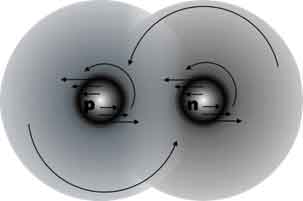 The initial displacement of the center of mass of the vortex by external forces and the subsequent resulting "samosmeschenie" occur in mutually perpendicular directions. The work is not done. |
Attached to the vortex flow p graviton environment shifts the center of mass of the vortex n up in the velocity towards the left. N vortex moves towards the vortex p, while continuing to get involved in the attached eddy p. The same thing happens with the proton p. Under the action of the rotating vortex flow n the center of mass of the neutron proton p goes down, in the velocity directed to the right, to the vortex n. At the same time he continues to get involved in the angular motion of the vortex n. The interaction of two vortices in a continuous medium of gravitons are attracted to each other, and begin to rotate around a common center. Forms a single rotating system - a new vortex. |
The electromagnetic interaction
ortex model did away with the myth of photons as quanta of the electromagnetic field. The vector of the electric interactions are gravitons - quanta of the electromagnetic field. The basis of interaction is the Bernoulli Effect.
The mechanism of interaction of electric charges can be attributed to the exchange mechanism. Charges share their flow of gravitons. Do positive charges emitted streams pravovintovye. Negative charges emit levovintovye flows. That creates a rotating flow interaction. In this case, the speed of radial flow of gravitons by the rate of rotation of neutrinos around a common axis, ie close to the speed of light. Dynamic pressure in the channel between the points E and P is very high. That is what defines a great strength of the electrostatic interaction.
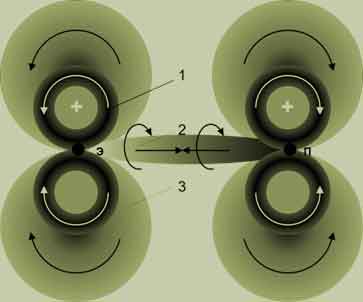
he figure of the electron (left) and a positron (right) thrown towards each other swirling flows of gravitons. If the point of the center of mass of the electron E put the plate perpendicular to the flow, then left on the plate will apply full pressure environment gravitons. To the right of the plate pressure will be reduced by the amount of dynamic pressure, as the rotation speed of the flow is parallel to the surface of the plate. Consequently, at the point E will be a pressure gradient, ie, the force that moves this point to the right, toward the positron. The same is true for the point P.
The mechanism of interaction of electric charges can be attributed to the exchange mechanism. Charges share their flow of gravitons. Do positive charges emitted streams pravovintovye. Negative charges emit levovintovye flows. That creates a rotating flow interaction. In this case, the speed of radial flow of gravitons by the rate of rotation of neutrinos around a common axis, ie close to the speed of light. Dynamic pressure in the channel between the points E and P is very high. That is what defines a great strength of the electrostatic interaction.
The gravitational interaction
Vortex model did away with the myth of the curvature of space by massive bodies. Carrier of the gravitational interaction are gravitons - quanta of the electromagnetic field. They create a dynamic mass near potoki.V based gravitatsioonogo field lies Bernoulli effect. The source of the gravitational force of the Earth is the pressure gradient interplanetary gravitons.
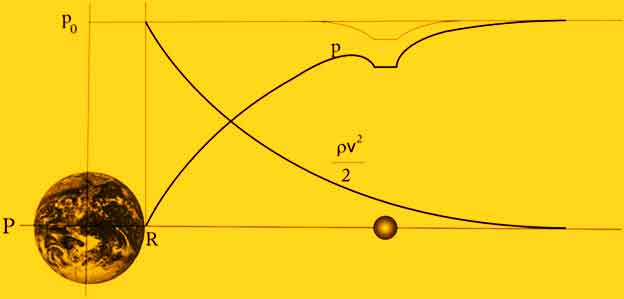
Earth and Moon are immersed in the relativistic gravitons, moving in all directions at the speed of light. The pressure in the undisturbed environment gravitons the same in all directions. Around the Earth and the Moon, as well as around each massive body, a flow of their own gravitons. The horizontal component of the flow creates a dynamic pressure.
Static pressure consists of the total pressure "interplanetary" graviton environment and the dynamic pressure of the flow of gravitons (? V ^ 2) / 2. The right figure is placed second body (eg, the Moon). If the moon were isolated from other bodies, the pressure in the neighborhood of a graph depicted above the figure. Overlay fields of Earth and the Moon leads to a "pit" in the resulting curve p. The gravitational force is radial pressure gradient environment. The force of gravity on both sides of the moon is the same and does not depend on whether or not she satellite.
Electric and gravitational interactions are based on the Bernoulli effect. In the interaction of charges dynamic flows of gravitons travel at near light speed. In the interaction of massive bodies of dynamic flow rate is low.
|
Vortex model did away with the myth of the planetary model of the electrons orbiting the nucleus. Electron spins with the kernel by the laws of motion of a solid body. |
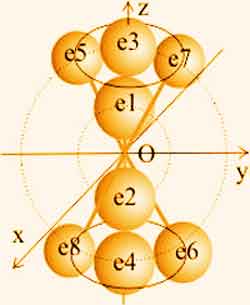 |
| The block diagram of an atom of oxygen. The core is at the point, each electron core electrostatically held by the charge of the vortex tube. Here as astronaut in space is connected to the vehicle with a hose. |
|
The atoms in molecules are fastened together by electrostatic forces. |
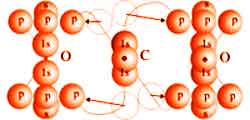 |
| Block diagram of a molecule of carbon dioxide. Gone to the acceptor atoms (atoms of oxygen), the electrons remain suppressed atomic nucleus donor (carbon) electrostatically charge with vortex tubes. After the transfer of electrons from the donor to the acceptor configuration outer shell carbon was helium, and oxygen was neon. The binding energy carried away by photons. |
|
Photons are the transmitter of energy between atoms. They change their momentum when passing inside the neutrino electron rings. |
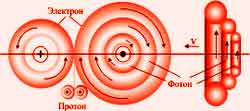 |
| Photon hits in the neutrino flux from the rotating gravitons. Field of the photon spin up in this whirlwind of a field of electron neutrinos on the principle "from hot to cold", ie while their velocities are not equal. Not transmitted momentum and angular momentum, so that the photon only increases its transverse energy. |
|
Why is the solar corona has a temperature of 10 ^ 6 K, while the surface of the star of 6000 K? |
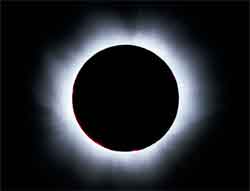 |
|
With a large selection of energy star there are millions of years old. Why do stars explode when falling energy release? |
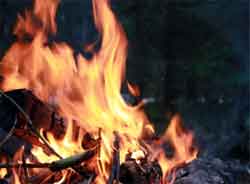 |
| Hottest part of the fire - the flame. That is where the process of combustion, ie compound of carbon and oxygen. This releases the binding energy in the form of photon radiation and kinetic energy of the combustion products: CO2, H2O, and smoke. The burning of wood is reduced to within the pyrolysis, ie, degradation of cellulose into simple components that differ from the embers in the form of a "tree of wind." Pyrolysis also leads to a relatively small release of energy networks, so embers heated, though not lit. |
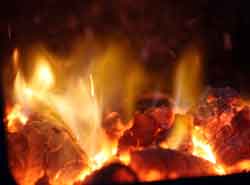 |
| After burning wood in the main fuel "Wood Wind" dies down, and the oxidation proceeds to do smut - they turn into hot coals and broken. |
Fully section in PDF format, view (Left Click) or download (Right Click) here. Leave your opinion in the guestbook.